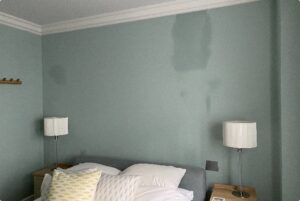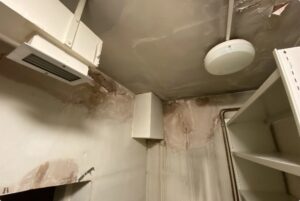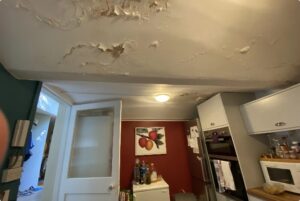Penetrating Damp

Do you think your home has penetrating damp?
Penetrating damp can be witnessed in buildings of any age when there is excessive rain to face or older structures with porous bricks or blocked gutters and cracked roofing. Whatever the situation, penetrative damp can seriously harm both the structure and the occupants. Penetrative damp is nothing but rainwater penetrating the masonry.
Penetrative damp is also known as rain penetration and it is caused by the horizontal movement of moisture or rainwater seeping through the walls at random points at all levels of a building, forming isolated patches of dampness on external walls after heavy rain. Rain penetration affects poorly installed wall ties or cavity walls, internal walls and buildings with solid wall construction.
Penetrative damp is mainly caused by a defective building or the presence of porous bricks allowing water to permeate through the walls.
Watch this video to find out more!
Signs of Penetrative Damp
- Damp patches at any level on internal walls that don’t dry
- Deterioration of plaster and paint
- Appearance of blisters, stain and salt
- Timber starting to decay and rot
- Skirting boards and window frames rotting
- Mould growth on internal decorations
- Damp as well as mould smell
- Moss growth on external walls
Penetrative damp can be identified with watermarks or damp patches isolated from windows or doors at any height
High readings can be found on the moisture detector while its raining but can also show low moisture readings when its dry.
Fix the problem at once, call in the experts at London Damp Specialists on 020 7458 4864.
What causes penetrating damp?
Rainwater permeating the wall horizontally is known as penetrating damp, and it is frequently the result of blown renders, clogged gutters, and downpipes. Additionally, roofing and window casings need to be inspected for deterioration, rotting, and cracks.
External basement and retaining walls must be protected from constant moisture intrusion by tanking treatments and interior walls by a chemical DPC and waterproof renders.
Building defects such as faulty roofs or windows must be rectified with proficient builders.
All our work is covered by a no-quibble 30 year guarantee at no additional cost.
How to treat penetrative damp
Penetrative damp treatment is more sophisticated than ever before.
Penetrative damp caused by poor cavity wall construction and wall tie installation on the damp internal walls can be set right with damp proof renders. It is occasionally necessary to treat exterior walls with water-repellent creams and paints in addition to weather-resistant paints and coatings. Blocked gutters and downpipes must be cleaned and cracked roof tiles must be repaired.
Breathable colourless water repellents allow moisture to escape rather than blocking them. Window sills and other water storage must be cleaned from dirt, moss growth and leaves.
Cement tanking and render systems can be introduced to treat penetrative damp problems caused by high external ground levels.
Penetrating damp treatments can include:
- Plaster removal
- Salt neutraliser
- Tanking Slurry
- Waterproof render
- Applying skim coat plaster
- Applying new external render
- Sealing exterior walls with clear waterproof sealer
Penetrating damp is a serious, complex problem
Which is why 1000’s of home owners have used London Damp Specialists. If you need expertise and skilled Damp Specialists Book your free survey today or call us direct on 020 7458 4864.
Customer Testimonials
Yes, any structure can be damaged by rising damp, mould, penetrating damp, condensation, although the older the house, the more likely damp will be present. If damp is present in a new house, you should contact the builder, as you should be covered by their warranty.
Yes, wallpaper and paint can temporarily conceal damp issues, but they worsen over time and promote mould growth. They don’t address the underlying problem of moisture. It’s crucial to identify and fix the source of dampness for long-term solutions.
We do not require payment until the work is dry and you are satisfied with the service.
We usually prepare a paper copy, plus the report is emailed to the customer and this usually happens within 24 hours. If you suspect that your home has damp issues, call us on 020 7458 4864 or fill in the form on our website.
There are two main types of damp, namely rising damp and penetrating damp and the difference is that rising damp comes from the ground, while penetrating damp can enter a building at any location.
Of course, the foreman would give you a clear understanding of the work to be carried out, plus he would be happy to answer any questions you may have. If you are interested, they would impart their knowledge, helping you to gain a deeper understanding of what is being done, plus they can give you a few tips to prevent condensation.
Our 5 Step Process
01
Initial Consultation
Tell us about your damp issue and we’ll guide you on next steps. It's an opportunity for you to ask questions and gather information.
02
Site Visit
Next, we visit your property to find the root cause of the issue. We’ll also assess the local environment, and take measurements or observations.
03
No Obligation Quote
Then we’ll send a detailed estimate of the costs involved, with no hidden extras, and provided to you without any commitment. You can review the financial aspect before making any decisions.
04
Work Carried Out
Our expert team carries out the work as planned, to the agreed timeline and quality standards, with minimum disruption to you.
05
Payment
The last step is payment, once the work’s complete, your home is dry and you’re satisfied with the results.


